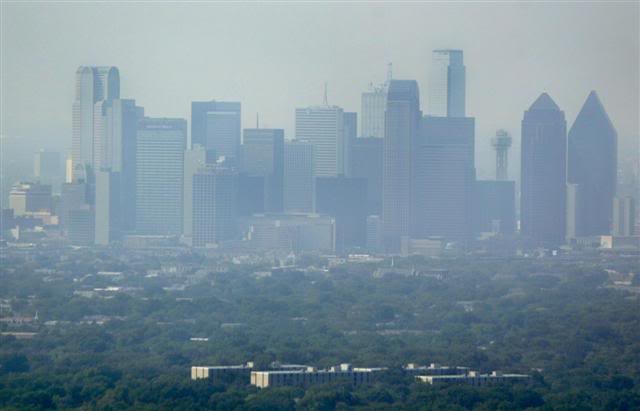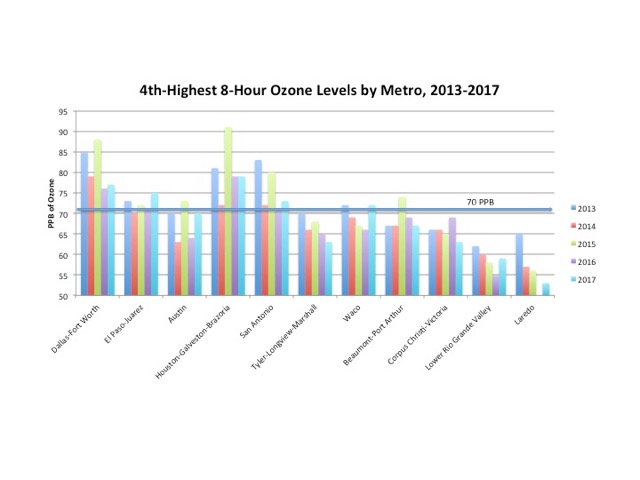By Cyrus Reed, Conservation Director

Bad air days are back. Before we discuss the “politics” of ozone pollution, better known as smog, let’s review the basics.
Ozone is composed of three oxygen atoms that come together to form ozone (O3). We like it way up in the atmosphere (the “ozone layer”) because it protects us from UV radiation from the sun. But down at the ground level it can have devastating effects on children, the elderly, and those with asthma or other health conditions. Ground-level ozone is formed when nitrogen oxides (NOx) emissions from cars and trucks, coal plants, and other industrial sources combine with volatile organic compounds (VOCs) from automobile exhaust and natural sources in the presence of sunlight. In most metropolitan areas, vehicles are the major (but not only) source of pollution contributing to ground-level ozone. Industrial sources in areas like Houston, coal plants outside of the Dallas-Fort Worth area, and oil and gas drilling also contribute to its formation in some areas such as San Antonio.
Because ground-level ozone has such obvious health impacts, such as premature deaths, increased heart attacks and increased incidence of asthma, we regulate it under the 1990 Clean Air Act, and we measure it through state, local, and private air monitoring stations strategically placed around our major metropolitan areas. The U.S. Environmental Protection Agency (EPA) is charged with setting a health-based standard (a limit on how much ozone pollution should be allowed in a given area) and determining which areas are considered in “attainment” with the standard and which areas are considered in “non-attainment.” The areas that are in non-attainment with the ozone pollution limit must come up with a plan -- called a State Implementation Plan (SIP) -- to lower ground-level ozone levels. Because science is continually advancing, under the Obama Administration, EPA declared that the new 2015 ozone standard is 70 parts per billion (measured over an eight-hour period) and non-attainment areas must come up with plans to get below that level in the coming years.
How Bad Are Ozone Levels In Texas?
While most of our major cities suffer days when ozone levels are high, through the years it has been the metropolitan areas surrounding Houston-Brazoria-Galveston and Dallas-Fort Worth that have suffered the most with high ozone levels. More recently, however, ozone levels in San Antonio and El Paso have also climbed. The EPA measures compliance not by the worst day in an area, but by the fourth-worst day. According to the most recent data (see below), those four areas violate the new standard, and by the rules, should be declared non-attainment.

2018, So Far
Ozone season has officially begun and those with breathing problems should take precautions. Until April 22, no cities in Texas suffered levels over an eight-hour period above the health-based standard. That does not mean that there were not times of the day when ozone levels were high and could hurt people. It simply means that levels were not high enough to be considered a violation.
Since April 23, bad air days will probably occur for the next five months, until lower temperatures start to depress ozone formation. Here are some recent ozone hotspots.
2018 Maximum Values Of Eight-Hour Ozone Levels Through April 25

What Are We Doing About It?
The EPA has yet to formally designate the areas in Texas that fail to meet the 70 ppb eight-hour ozone standard . In fact, back in February 2018, EPA said it intended to declare the Dallas-Fort Worth and Houston-Galveston-Brazoria area non-attainment, but after a special request from Governor Greg Abbott, it decided to wait for additional information to decide about the San Antonio area. Several groups, including the Sierra Club, went to court to force EPA to make a decision. In March, the courts told EPA they must make a decision by July 2018 on which areas of the state (and the nation) are non-attainment. The public has been given until April 30 to make any comments on designations. Here is, in a nutshell, what Sierra Club is telling EPA: Follow the law!
If monitors in the Houston and Dallas areas, as well as the El Paso and especially the San Antonio area, show that those areas fail to meet health-based standards, then they are, by definition, non-attainment areas. We should declare those areas non-attainment and require the state to come up with a plan to clean them up! In the meantime, please be careful out there in the hot Texas sun. Until we clean up our transportation, coal plants, and oil and gas facilities, there are times of the day in certain cities where it is just not good for your health to breathe the air. To check on local ozone levels, please visit this TCEQ page.